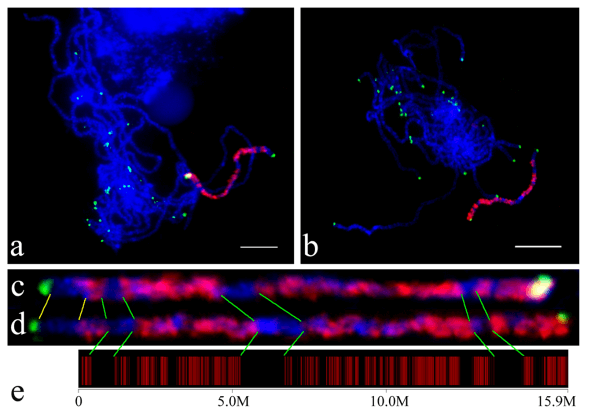Comparative Oligo-FISH Mapping Service
Comparative Oligo-FISH Mapping
Karyotype analysis is very important for the discovery and identification of eukaryotic species, especially for the identification of individual chromosomes. This is challenging for most non-model biological species, because closely related or evolutionarily related species have similar karyotypes in most lineages. The karyotype of eukaryotic species can represent the number, size and shape of all chromosomes in the nucleus. This is why the karyotype is used as the most general description of the basic genetic makeup of a single eukaryotic species. Oligonucleotide-based FISH technology is a powerful molecular tool for chromosome identification and karyotype analysis, especially for non-model organisms. The development of digital imaging and fluorescence-based tools has made FISH more and more widely used, making cytogenetic research convenient for species with very small chromosomes or fewer researchers. The unique "bar code" formed by selecting and marking oligonucleotides located in specific regions of each chromosome has an impact on the comparison of differences between different species or strains. Comparison Oligo-FISH mapping is a chromosome mapping service for 2 or more species based on oligonucleotide probes. This technology helps to discover potential structural variations of chromosomes in related species based on similar karyotypes.
 Fig 1. Oligo-based painting of chromosome 19 in two Populus species. (Xin H, et al. 2018)
Fig 1. Oligo-based painting of chromosome 19 in two Populus species. (Xin H, et al. 2018)
Comparative Mapping Services
This service is aimed at the comparative study of strains and species evolution of crop species that have sequencing data. We developed this service by selecting and marking oligos located in specific regions of each chromosome. The Oligo-FISH bar codes can be designed specifically for the selected chromosome or region of the sample. Customers can also upload their own designed sequence. After forming the optimal probe design plan, we will synthesize the oligonucleotide sequence and label the synthetic probe. This process will be checked by our team of experts. Then the customer submits the sample to our laboratory, our experimental platform completes the FISH test and harvests the images and data. Finally, our bioinformatics team uses data software and digital imaging methods to process the data and give the final result.
 Fig 2. The application of comparative mapping in breeding and evolution.
Fig 2. The application of comparative mapping in breeding and evolution.
Technology Features
Oligo-FISH bar codes have the following major advantages:
- Oligonucleotide-based FISH probes can be designed in any species with sequenced genomes;
- Oligonucleotide probes can be selected from multiple regions of the same chromosome, and an unlimited number of possible patterns can be designed for each chromosome;
- Single or several oligonucleotide libraries can be designed to identify all chromosomes in plant species with sequenced genomes, and form Oligo-FISH barcodes with species characteristics;
- The barcode probe library formed can potentially be used to identify homologous chromosomes in distantly related species, and this feature can be used for evolutionary research;
- The designed barcode oligomeric FISH probe is cost-effective and can be maintained as a permanent resource;
Creative Bioarray provides advanced Comparative Oligo-FISH Mapping services to researchers who study species evolution and breeding. Our FIS experimental platform has many FISH project experience, and provides the highest quality Oligo-FISH probes and accessories products, allowing customers to enjoy one-stop service. With our technical expertise and complete platform, you will get the best solution. If you are interested in our Comparative Mapping service, please contact us for cooperation. We look forward to cooperating with you in the near future.
References
- Xin H, Zhang T, Han Y, et al. Chromosome painting and comparative physical mapping of the sex chromosomes in Populus tomentosa and Populus deltoides[J]. Chromosoma, 2018, 127(3): 313-321.
- Li G, Zhang T, Yu Z, et al. An efficient Oligo‐FISH painting system for revealing chromosome rearrangements and polyploidization in Triticeae[J]. The Plant Journal, 2021, 105(4): 978-993.
All products and services on this website are only suitable for non-medical purposes.


 Fig 1. Oligo-based painting of chromosome 19 in two Populus species. (Xin H, et al. 2018)
Fig 1. Oligo-based painting of chromosome 19 in two Populus species. (Xin H, et al. 2018) Fig 2. The application of comparative mapping in breeding and evolution.
Fig 2. The application of comparative mapping in breeding and evolution.


